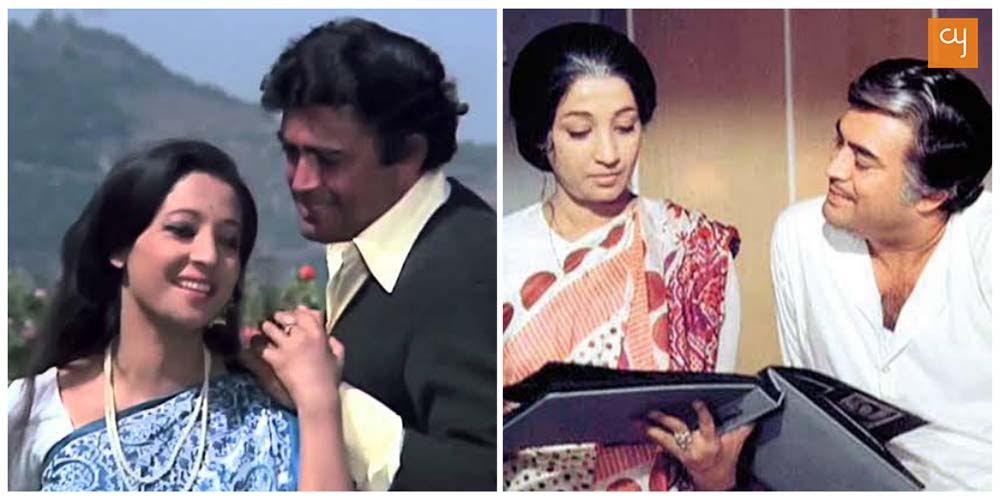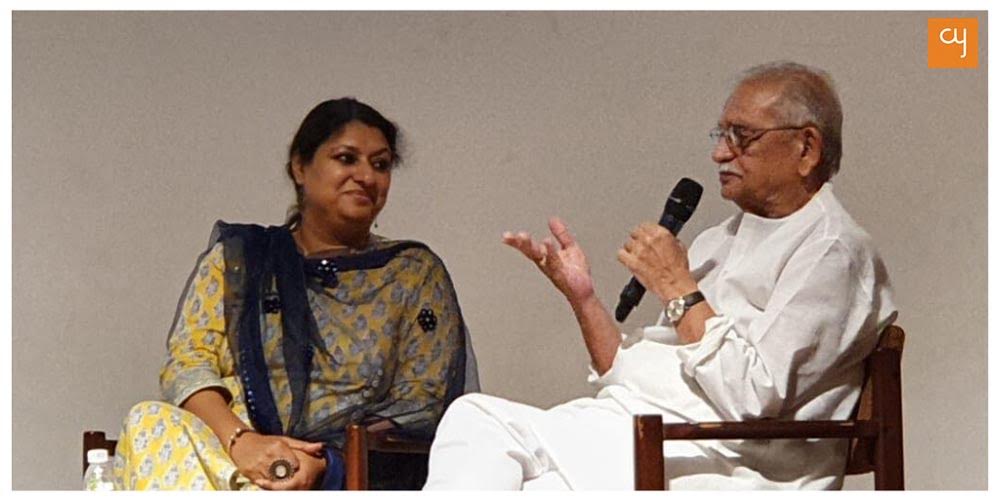Rediscovering Gulzar’s ‘Aandhi’ through Saba Mahmood Bashir’s Book
Gulzar Saab is a name familiar in cinema for bringing revived lyricism through his poetry in filmmaking. Earlier this year, as a project to return to the oeuvre of Gulzar the filmmaker, HarperCollins released three books that looked back at three of his films from the late 70s and 80s. These were Aandhi, Angoor and Ijaazat.
Each book in the series carries insights into the films bringing nostalgia for the ones who were touched by them and opening entry points for those who need to be introduced to them. While Sathya Saran, the Consulting Editor at Harper Collins looks at Angoor, an adaptation of Shakespeare’s Comedy of Errors, Mira Hashmi, Assistant Professor of Film at the Lahore School of Economics rediscovers the characters in Ijaazat which was based on Subodh Ghosh’s Bengali novel Jatugriha.
However, this brief essay discusses Saba Mahmood Bashir’s work on Aandhi, a film that created quite a stir with its release leading to censorship, which resulted in addition of new shots into the original script to arrive at clarity for those who demanded so. Prof. Bashir, therefore, explores the background of Emergency in the country during which the film was released and the issues that it faced because of it. However, she gives it only a chapter’s worth of space after Gulzar clears the air around it. She moves on to a more nuanced discussion of the film as an art form, bringing a brilliant curiosity about the art of Gulzar’s cinema itself.
Aandhi was released in the year 1975. It is a film which traces the journey of two lovers who decide to get married but have to separate from each other because of disagreements. JK is an assistant manager at a hotel and Arti is a politician’s daughter who has studied law and decides to join politics to serve the people. JK and Arti fall in love with each other when they meet. However, after marriage JK insists that Arti leave politics because it is dirty. Arti’s father, who is a politician and a businessman, on the other hand, doesn’t approve of JK’s role as a manager at a hotel.
The film opens with the election campaigns where we see Arti Devi and her party symbol “panchhi” (a bird). We are also given a glimpse of her opponent, Chandra Sen who can be seen turning the voters against Arti Devi, using words like: “Yeh panchhi kisi ke nahin hote, yeh panchhi kisi ke nahin honge… Ud jayenge dana, paani aur vote lekar” —these birds are not loyal to anyone! They will never be loyal to anyone! Snatching away your share of food, they will fly away after getting your votes.*
As the film progresses, we see many of Chandra Sen’s efforts to pull Arti Devi down. However, this is politics more than a decade after Arti Devi and JK have separated. At this election, while visiting her constituency, Arti Devi decides to stay at a hotel so she could address the voters and later finds out that JK owns it. Against all the political background, therefore, Gulzar takes us into a moment which is what the film really is about, the story of two lovers, as Arti goes to meet JK for the first time in many years when she finds out about him.

This is where he tells us the story of their love through the years in flashbacks through ordinary but important moments, as they sit and eat dinner together or share a cup of tea and think about old times when they communicated through it. For instance, when Arti put JK’s hand into the steaming cup of tea to wake him up. Prof. Bashir calls the flashback “a favoured tool of Gulzar” where the screenplay “moves through different planes, comparing the two protagonists and revealing the contrasts in the way various issues are experienced by a married couple.”
Saba Bashir’s insights into the film
In her book, Bashir takes us into the making of this film—a film about the transformation of two lovers over the years, especially JK’s who begins to support his wife later in the film unlike the time when he wanted her to be home, which led to Arti leaving their home, Ibsen’s Nora-like. It is a film that continues to stay a classic despite major resistance by Indira Gandhi’s supporters at the time, who felt it to be a portrayal of Indira herself but in “bad light”— smoking, drinking at a party, and in love. Gulzar, however, clears that it has nothing to do with her.
Bashir’s relationship with Gulzar’s works can be traced to an earlier time when she worked on her PhD thesis comparing Gulzar’s film and non-film poetry. The book became I Swallowed The Moon, which carries translations of his works. From her understanding of Gulzar the poet, to Gulzar’s filmmaking techniques, to the controversy around Suchitra Sen’s character, and to casting Sen and Sanjeev Kumar for the lead role, Om Shivpuri for Chander Sen’s and Om Prakash for Lallu Laal’s, a vicious man from Arti’s party who hatches a plan against Chander Sen without Arti Devi’s knowledge, Prof Bashir has given us a film to rediscover as we watch it again through her. She also gives poetry and language two deserving chapters discussing the role they play in strengthening the narrative, not just in terms of placing songs accurately at different levels of the relationship but also the choice of the names of the newspapers as well as the dialogues which point at larger complexities in all the relationships within the film:
“Given the complicated nature of JK and Aarti’s relationship, only a master of wordplay could handle their scenes with maturity. Given the awkwardness in the air when JK and Aarti suddenly meet after a gap of nine years, the dialogues required a lot to be conveyed using the bare minimum of words.”
Sharing interesting anecdotes from the making of the film and the creative process, in an appendixed, bonus interview with Bashir, Gulzar saab too is unabashed.

He shares his friendship and collaboration with Kamleshwar Prasad Saxena, the writer who wrote the novel Kali Aandhi based on Aandhi, the story of which was written by him, while Gulzar wrote the script. While there was a confusion created publicly by press and media on who the story belonged to, Gulzar talks about the collaborative process in which writers work, how parts of the film come together to make the whole:
“There should be no misunderstanding here—this [is] a mutual arrangement, and it happens among writers. Say I write a poem and he writes a story on it, or he writes a story on which I write a poem. It’s all in good faith. It is only the outside world that could interpret this as something disgraceful.”
It is then only a mistake to not pick up the book and know more about the way Aandhi came together as a film, as one that is such an important contribution to Indian cinema that it finds its relevance 40 years later today as well.
Yatra Archives

 How Tulika Books is creating impact in children’s lives through picture books
Nandini Varma
How Tulika Books is creating impact in children’s lives through picture books
Nandini VarmaAug 21, 2019
A children’s book about a boy who feels like a girl. And about a child brought up by grandfathers. These are some of the stories published by Tulika Books, who have been making children’s picture books since 23 years. Little…
 Dalgona Coffee: A worldwide social media trend about home-made café experience
Harshil Shah
Dalgona Coffee: A worldwide social media trend about home-made café experience
Harshil ShahApr 2, 2020
While the lockdown has ignited various trends on social media, one that has received a major global following is #DalgonaCoffee. With thousands of posts on its name, here’s all you need to know about the Dalgona Coffee wave. I first…
 Leonardo, Michelangelo, Raphael and Donatello—Artists or Teenage Mutant Ninja Turtles characters?
Harshil Shah
Leonardo, Michelangelo, Raphael and Donatello—Artists or Teenage Mutant Ninja Turtles characters?
Harshil ShahNov 5, 2019
Did you ever wonder where the Teenage Mutant Ninja Turtles’ characters got their names from? Well, your search is complete. Here is a brief introduction of the artists from whom the creators of TMNT took inspiration. Teenage mutant ninja turtles,…
 The call of the mountains: orthopaedic Dr Yatin Desai’s advice on trekking
Himanshu Nainani
The call of the mountains: orthopaedic Dr Yatin Desai’s advice on trekking
Himanshu NainaniMay 24, 2019
In this piece 64 year old Dr Yatin Desai, shares with CY his inspiring story of how to scale towering mountains with utmost ease and how this life adventure activity can shape human character and health. Chances are high that…




